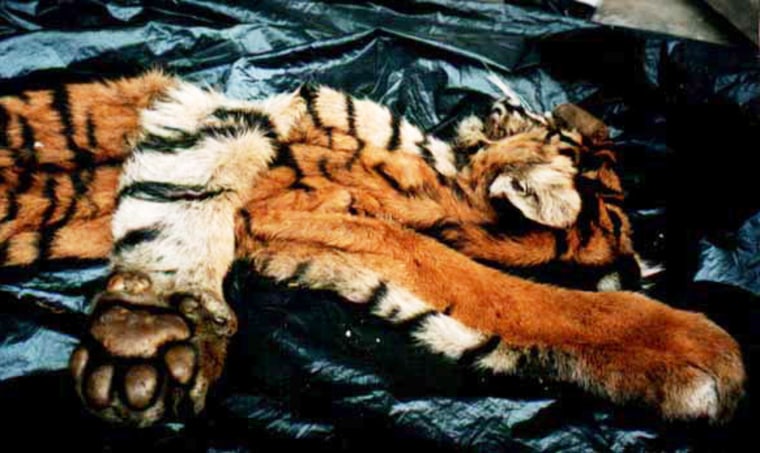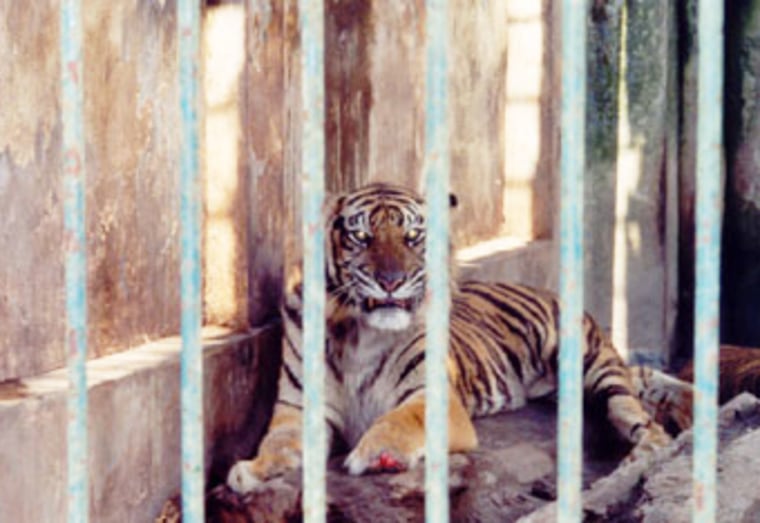Unless poaching for body parts is stopped, Indonesia's Sumatran tiger could be the first large predator to become extinct this century, according to a report Tuesday by a network that monitors the illegal trade in endangered species.
Three of the world’s eight tiger subspecies have already gone extinct in the past 70 years. The remaining five subspecies are all endangered.
The report by Traffic found that despite an international ban on trading in tiger parts, at least 50 Sumatran tigers were hunted each year between 1998 and 2002. The total population of Sumatran tigers — found only on the Indonesian island of Sumatra — is estimated to be 400 to 500.
Bone used for traditional medicine
"Indonesian authorities must urgently increase enforcement efforts and implementation of laws banning trade in tiger parts and products, or extinction is near for the last of Indonesia’s tigers," the report concluded. "Numerous sources indicate that a lack of political will at best, and widespread corruption at worst, hinders enforcement of trade and hunting bans."

The tigers are hunted for skins as well as body parts such as bones, which are ground up and used as traditional medicine in some areas of Asia.
The World Wildlife Fund, which joined with the World Conservation Union to create TRAFFIC, noted that Indonesia already has lost two tiger subspecies: the Bali and Javan tigers. They became extinct in the 1940s and 1980s, respectively.
No safety in national parks
TRAFFIC said its report was based largely on undercover work that found:
- Tiger products for sale in 17 of 24 surveyed Sumatran towns. A fifth of 453 shops visited offered tiger parts, especially teeth and claws sold as charms and trophies.
- A vast international trade in tiger parts sold to China, Japan, Malaysia, Singapore, South Korea and Taiwan.
- Tigers are killed primarily with inexpensive and simple-to-make wire cable leg-hold snares.
- The animals are hunted deep within national parks.

TRAFFIC monitors illegal trade for the Convention on International Trade in Endangered Species, or CITES. Parties to the U.N. convention meet this week in Geneva, where TRAFFIC officials said they would urge Indonesia to crack down.
"Action should be taken against the markets, trade hubs and retail outlets highlighted in the report, especially in northern Sumatra," TRAFFIC's executive director, Steven Broad, said in a statement accompanying the report. "More specialized anti-poaching units also need to be urgently established."
Tigers lose habitat to logging
The TRAFFIC report noted that Sumatran tigers have also faced a second major pressure: widespread logging of their habitat by multinational paper companies.
The World Wildlife Fund called for a moratorium on clearing in Sumatra's lowland rainforests by Asia Pulp and Paper.
"APP, which supplies office paper and student notebooks to U.S. retailers, has eliminated more than 1.2 million acres of tiger habitat since 1998," the group estimated.
The TRAFFIC report is online at www.traffic.org.
